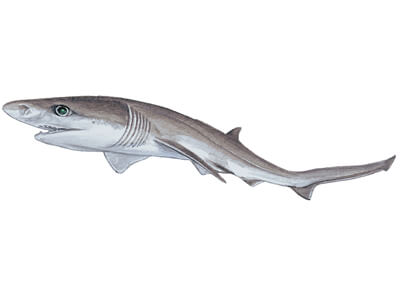Hello ladies and gents this is the Viking telling you that today we are talking about
THE SHARPNOSE SEVENGILL SHARK
The sharpnose sevengill shark (Heptranchias perlo), also known as one-finned shark, perlon shark, sevengill cow shark, sharpsnouted sevengill or slender sevengill, is a species of shark in the family Hexanchidae, and the only living species in the genus Heptranchias. Found almost circumglobally in deep water, it is one of the few species of sharks with seven pairs of gill slits as opposed to the usual five. The other shark species with seven gill slits is the broadnose sevengill shark. Though small, this shark is an active, voracious predator of invertebrates and fish. When caught, this species is notably aggressive and will attempt to bite. It is of minor commercial importance.
Usually measuring 60–120 cm (2.0–3.9 ft) long, sharpnose sevengill sharks attain a maximum length of 1.4 m (4.6 ft). This species has a slender, fusiform body with a narrow, pointed head. The eyes are very large and fluoresce green in live specimens. The mouth is narrow and strongly curved, containing 9-11 teeth on either side of the upper jaw and five teeth on either side of the lower. The upper teeth are narrow and hook-shaped with small lateral cusps, while the lower teeth are broad and comb-shaped (except for a symmetrical symphysial tooth). Unlike most other sharks, there are seven pairs of gill slits that extend onto the throat.
A single small dorsal fin is located behind the pelvic fins, with a straight front margin, narrowly rounded tip, and concave rear margin. The pectoral fins are small with a weakly convex outer margin. The anal fin is small with nearly straight margins. The caudal peduncle is long, and the distance between the dorsal fin origin and the caudal fin is more than twice the dorsal fin base.
The closely overlapping dermal denticles are very thin and transparent; each is longer than it is broad, bearing a distinct median ridge and two lateral ridges ending in marginal teeth. The coloration is brownish gray to olive above and lighter below; some individuals have dark blotches on the body or light posterior fin margins. Juveniles have dark blotches on the flank and dark tips on the dorsal fin and upper caudal lobe.
And as always have a chilled day from the Viking

Comments
Post a Comment